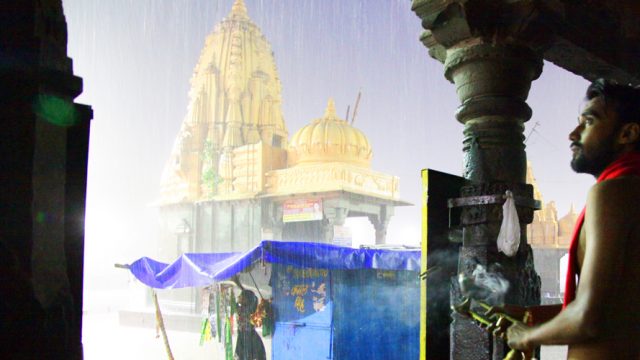The serpentine queue outside the Mahakaleshwar Temple shuffled forward sluggishly. Though the night was cold, no devotee complained or protested. On the contrary, they buoyantly clapped, sang, and chanted. Ujjain’s famous temple is dedicated to Mahakal, the most powerful of the 12 jyotirlingas in the country. He is the “Controller of Time” and “Destroyer of all Elements” and, it seemed, also intent on teaching us anxious travel writers the merits of patience and tolerance.

“Kaal” denotes “time” as well as “space as darkness” and whatever lies beyond it is Mahakal. Since everything in this world occurs in cycles, in relation to time and space, believers throng to seek the blessings of Mahakal, the deity who rules these dimensions. The deity is said to help the departed attain moksha, liberation from the endless cycle of birth and rebirth. The use of ash is symbolic for washing off sins, and connecting with the divine.
While this famous tantric temple is open through the day, its unique daily ritual of bhasm arti (consecration with ash) takes place only in the dead of night. The Lord is first ceremonially “awakened”. The ritual begins with jalabhiseka or bathing of the linga with water, milk, honey, and curd. It is anointed with shringar, a sandal and turmeric paste, and decorated with bael leaves (bilvapatra) and flowers, before finally performing the first arti of the day.


This first arti of the day includes bhasm (ash). Unlike the sacred ash found in most temples, in the past the Mahakal bhasm arti required chita bhasm or ash from the first funeral pyre cremated at night. Today, the practice has changed and temple authorities prepare fresh ash from cow dung and present it in a thin cloth pouch. The token presence in the sanctum sanctorum, of an ash-smeared aghori sadhu Baba Bam Bam Nath from the cremation ghat, completes the ritual. People watch the chief priest dramatically swing and wave the pouch over the linga, as clouds of ash shower down, covering it in grey dust. This lasts a few minutes, and is followed by an arti with oil lamps, the clanging of bells and cymbals, drumbeats, and the chants of “Om Namah Shivaay”, “Jai Mahakal” and “Har Har Mahadev” resonating through the air. It is a powerful, soul-stirring, and overwhelming experience. Some even claim to see a divine light (jyoti) emanate from the linga, during this arti.

THE INFORMATION
Shree Mahakaleshwar Temple
Address: Jaisinghpura, Ujjain.
Tel: 0734-2550563
E-mail: [email protected]
www.mahakaleshwar.nic.in
Hours: Temple is open from 6 a.m.-11 p.m.; Bhasm arti 3 a.m.-6 a.m.

How to attend the bhasm arti: To attend the bhasm arti you need to book in advance online. Reservations open 15 days in advance. About 500 people are allowed darshan from the waiting hall, and another couple of hundred are issued VIP ticket and accommodated closer, inside Nandi Hall. TV screens in both the halls broadcast the proceedings for all to see.
Entry to the main hall is free. You only pay for the offerings you take inside. Book a free slot online (dic.mp.nic.in/ujjain/mahakal/default.aspx) or at the Mahakaleshwar Temple counter (3 p.m. onwards for next day’s darshan).
VIP tickets cost ₹250 and is available between 12 noon and 2 p.m. for the next day. VIP ticket holders stand in a shorter queue, sit in Nandi Hall and are given access to the sanctum sanctorum.
Tips:
- People queue up as early as midnight to avoid the push of large crowds.
- The puja beings at 3 a.m. and the bhasm arti at 4 a.m.
- Carry an ID card (PAN card is not accepted) and bar-coded tickets.
- If you enter the sanctum sanctorum for jalabhisheka, traditional attire is a must (saris for women, dhotis for men). There’s no dress code for the bhasm arti as you’re seated in a tiered pavilion behind barricades.
- Carry a metal pot to pour water onto the linga, if it is allowed.
Visit MP Tourism
Madhya Pradesh
MPonmymind
Anurag Mallick


